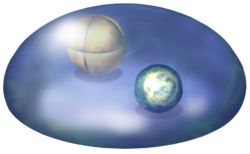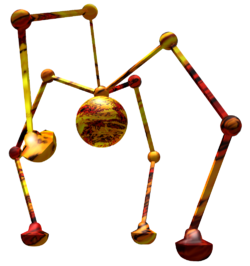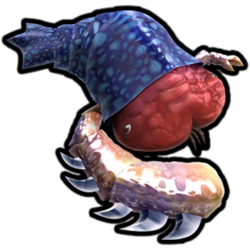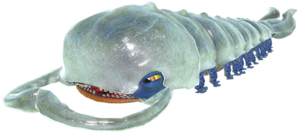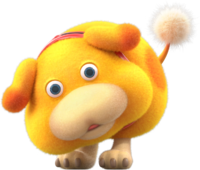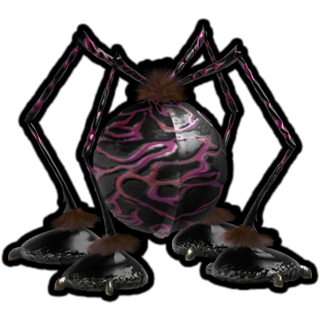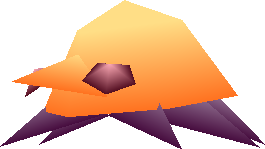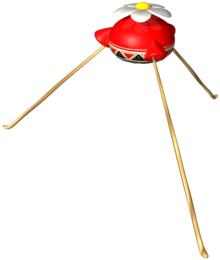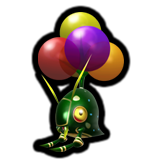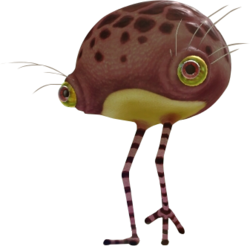User:NintendoPanda101
Welcome to Ninpan's Daily Creature Feature.
On this page I will have a daily writing on a Pikmin creature. To keep things interesting this will feature headcanon content, such as technical names for enemies that didn't appear in Pikmin 1, and ignoring basically everything Pikmin 4 has to say about Pikmin 1 enemies. When I started this on this wiki, I was already up to day 10 on a Discord server. I will not be covering Hey Pikmin enemies. Feel free to fix any typos!
Hi, you may have noticed I stopped updating this awhile ago. I still have quite a few I've done that I need to put on this page, but I did stop writing them. I'll return to this eventually, just not now.
Day 1: Emperor Bulblax
Emperor Bulblax, also known as Oculus Supremus or the Emperor Grub-Dog, is a young version of the Sovereign Bulblax, the apex predator of the ecosystem. It hides underground to ambush prey, either using its rocklike hump to disguise as a stone or using its eyestalks as camouflage in sandy environments. The method of camouflage it uses depends on how mossy its back is, which can also grow plantlife. It has a long purple tongue it uses to capture prey, and it can be tricked into eating pretty much anything. Its rocky back is green underneath as well, and contains several pores that act as soil for the plantlife that grows. It exhibits pack behavior and a larger version has been found, in-between the Emperor and Sovereign Bulblax, named the Heir Bulblax.
Day 2: Goolix
Goolix, also known as the Greater Water Slime, or Binuclei Siphonophores, is a gigantic single celled organism with a body comprised of a watery membrane. It is a major predator, however, it is a rare sight. It appears from thin air, disguising as a simple patch of moisture in the ground, similar to the nectar droplet disguise of it's single nuclei'd cousin, Foolix. It will stretch its body to absorb prey, although non Blue Pikmin are simply left suffocating with a bubble on their head. The crystal nucleus is the creature's nervous system, while the fleshy nucleus is the creature's defense system, weakening prey and absorbing nutrients. Most prey will drown before the absorbtion process begins. Sudden change in weight on either nucleus will cause the Goolix to lose control of it's shape, slamming its nuclei together and injuring it in the process. The adult Goolix is two opposite sexed members of the same species, which merge together shortly after meiosis from a grown Goolix.
Day 3: Beady Long Legs
The Beady Long Legs is a large spider-like creature also known as the Arachnorb or Psuedoarachnia Armoralis. It is a sturdy creature, admired by researchers for its large stature. It falls from what seems to be the sky to scare off intruders with footfalls. It has no natural predators, not only due to size and high resilience, but also its armor like wax coating, which gives it its unique pattern. This armor may be to ward off parasites, as insects tend to climb up the legs of unwaxed relatives, namely the Shaggy Long Legs. The Beady Long Legs is known to make webs, but its feeding habits are unknown. Like other Arachnorbs, it has an oddly destructive death procedure. When it's weakened, it will start to flake away, and will smoke at the joints. When it dies, a jolt of electricity surges through it, and it either explodes into fireworks and smoke, or disintegrates as it falls to the ground.
Day 4: Fiery Bulblax
The Fiery Bulblax, also known as the Knighted Grub Dog, or Oculus Volcanus. The Fiery Bulblax shares the melted features and protective hide of the Emperor Bulblax however its behavior is more akin to the common grub dog. Its highly resistant to attack beyond it's flame coating, which comes from secretions of a highly flammable wax. This wax reacts to chemicals in the Bulblax's cell structure, creating this fire. In addition, the cell structure is highly spongy. to spread the heat more evenly, and protect the inner organs. This creature is rare, as it often sets fire to plantlife nearby, and, if a large amount of vegetation is nearby, can end up getting itself killed in the inferno. Despite appearance, the two differently shaped eyes are not a result of the inferno, but a normal feature of the Bulblax. It is believed that Bulbears and the Fiery Bulblax evolved from the Emperor Bulblax, and that early Fiery Bulblaxes became modern Bulborbs.
Day 5: Burrowing Snagret
The Burrowing Snagret, also known as Shiropedes Annacondi, and the White Headed Snavian, is a bird serpent hybrid that serves as a weak boss that often appears in groups. It lives underground, emerging and pecking with great speed to capture prey. When unearthed from the ground, a single foot can be seen. Snavians are the most distributed family other than the Grub Dog family, being seen in almost all regions. While it's not very common to find a Snavian due to large size, one should still expect one to be living in any region they enter. The Burrowing Snarrow, a relative of the Snagrets, has yet to be studied in detail. Observations include tail markings, a white and fat body, and a more scruffy head.
Day 6: Wollyhop
Wollyhop, also known as the Amphibituber and Amphicaris Albino, is a member of a frog like family known for vaguely resembling potatoes. They are also known for their behavior of crushing opponents by jumping high in the air and inflating their jowls, deflating to fall back down and crush anything with their weight. The Wollyhop is the original member of this species, and while once a blue color, has become albino due to cave dwelling. Wollyhops are the most aggressive member of the family, as while other members crush foes to protect eggs, the Wollyhop seems only to do so out of spite, even going out of the way to crush other creatures when nightfall comes. They also have keen senses, being able to detect intruders from behind. The Wollyhop was once considered one of the most dangerous species to Pikmin, but with the discovery of the crush proof Rock Pikmin, this is no longer the case.
Day 7: Segmented Crawbster
The Segmented Crawbster, also known as the Carcinized Pillbug, and Parastacoidea Reptantia, is a large crawfish/lobster like creature, showing a large, spiked claw not unlike a club, with a proper claw, albeit small, on its left. This creature has an incredibly aggressive disposition despite its goofy looking eyes, and will ram into prey at full speed, rolling into a ball and causing avalanches with the severity of the impact. It's actually an herbivore despite its aggression, considered one of the most well defended herbivores besides the waxed members of the Arachnorb family. On it's underbelly is a large red bulge, not unlike a zit. This bulge can be damaged and contains vital organs, and when damaged too much, explodes as the Crawbster writhes in agony. The contents of the stomach are released when it explodes, allowing effective, if not cruel study of the Crawbster's diet. It seems to prefer habitats that were once inhabited by an unknown intellegent species (humans), only being found in what appears to be a room of tile.
Day 8: Mamuta
Mamuta. Also known as Hortanulus Assymetria or the Great Protector Statue, these creatures are incredibly odd. Their assymetric shape and piercing gaze make them seem threatening, but they are actually incredibly gentle. They seem to have a connection with Pikmin, the patterns on the wrist matches the pattern seen on Onions, Pikmin nests. These patterns are only seen on the inorganic onions, implying an even further connection. Mamutas will often be found relaxing, but if angered, will pound any attackers into the ground. If these attackers are Pikmin, they will be planted into the ground and grow a flower. Mamutas do not take kindly to these Pikmin being pulled out of the ground. The Mamutas are proper gardeners, growing fields of crops for food and flowers for decoration. Underground specimens are inherently aggressive due to lack of food. When relaxing, Mamutas have been known to purr or create donkey like sounds. Mamuta eyes actually have white to them, which may make for an unsettling thought, but they are quite cute once you get used to them.
Day 9: Breadbug
Breadbug, also known as the Vanilla Breadbug and Pansarus Gluttonae. This little guy is a bumbling scavenger which will take anything it can pull back to its nest or another hiding spot. They have a strong grip and very thick skin, protecting them from almost all attacks. They seem to enjoy music, as they can be found humming various tunes while out and about. The Breadbug shares several similarities with Grub Dogs, and in fact share the same vocalizations. This makes it rather likely that Breadbugs and Grub Dogs have a common ancestor. Breadbugs have become a favorite for researchers, who find them heart melting. The inside of its nest is quite huge, and with proper food sources, a Breadbug can live up to 20 years with minimal signs of aging. Breadbugs are an elusive prey species, as their blubber makes them impossible to chew down on. Nevertheless, Grub-Dogs have an interest in Breadbugs, leading to the evolution of various Breadbug mimics, various species of Breadbug that look almost exactly like Grub Dogs.
Day 10: Sovereign Bulblax
The Sovereign Bulblax is an incredibly old Emperor Bulblax, and shares the same nicknames. This massive creature is about half the size of a tire rim, and is by far one of the strongest creatures on the Distant Planet. It does not share pack behavior with its younger counterpart, and it can jump 3 times its size into the air to completely crush any prey, turning their bones into dust. This horrifically durable creature can survive swallowing over 30 bomb rocks. Much larger vegetation grows on its back than in it's younger state, including Blaxcaps and Bulborle. The specimen shown in this image has Bulborle. To find out the age of a specimen, one can count age rings on its hide, specimens with over 100 age rings have been discovered. Captain Olimar fought this creature as his Final Trial when he crash landed on the Distant Planet, a much older specimen, possibly around 250 years old. It did not die, and merely retreated into the ground. The only creatures known to rival the Sovereign Bulblax are Man-At-Legs, Raging Long Legs, armed Titan Dweevils, Plasm Wraiths, and Ancient Sirehounds.
Day 11: Smoky Progg
The Smoky Progg, also known as The Great Crumbling Statue and Magovum Vaporus, is a malformed larval Mamuta. Mamuta lay large eggs, and through a variety of factors, the fetus can deform. This can range from consumption of strange substances from the parent or intense impact on the egg. The green melting skin is supposed to turn into a Mamuta's normal skin in high temperatures. This creature can shoot and leave behind hazardous toxic sludge known as gloom. A golden pearl seems to constantly regenerate the melting creature, and seems to be what a Mamuta heart looks like. This pearl can produce an enormous amount of Pikmin when taken to an onion. Mamuta will often create odd patterns of soil around eggs, possibly as markers. When a Smoky Progg is born, it is inherently aggressive towards all but adult Mamuta, the Mamuta will attempt to take care of the creature as one of their own, but it will not last. A Progg in the family will discourage Mamuta colonies reproduction for months, sometimes even years.
Day 12: Foolix
Foolix, Mononucleui Stellacodus, or the Greater Mimic Slime. This water slime mimics a drop of nectar, a common sight on the distant planet, in order to lure in prey. Unlike the Goolix, prey are absorbed alive, with secretions from the lumpy nucleus. The flagella on the nucleus control the organism's gelatinous body, which can split into pieces during dire circumstances. It is immune to most elemental attacks, and while it doesn't have as high durability as the Goolix, it is still unlikely uncoordinated species can kill the organism. Two members of the opposite sex can merge and take a form similar to the Goolix, but this doesn't seem to be an intentional behavior. Fooli often let themselves be consumed, so they can overtake the eggs in pregnant females. Nectar is often found in the eggs of this planet, so this strategy ensures a sucessful hunt.
Day 13: Purple Pikmin
Purple Pikmin, also known as Pikminidae Yokozunum and the Feeler Carrot, are a species of Pikmin known for their bulk. Their sheer weight for their size will injure creatures they land on, and sometimes even briefly dizzy them. The Purple Pikmin can carry 10 times as much as other Pikmin types, a small group can carry even the largest of creatures. Their feelers let them detect the world around them, and also seem to give them a homing sort of ability when they fall, allowing them to hit creatures dead on. Purple Pikmin have very good balance, and trip less than other types. They also can resist high winds and pop bubbles they get trapped in instantly. They have a strong resolve that lets them stow away fear as well, seemingly as a drive to protect other Pikmin types. The color comes from rich polyphenol antioxidants, which allows the Purple Pikmin to ward off disease. Their incredibly dense muscle fibers slow them down when moving, Purple Pikmin seem to be one of the earliest types to evolve, and they remained underground alongside their Onions for a long time, warding off the high amount of hostile species with their strength.
Day 14: Giant Breadbug
The Giant Breadbug, also known as Pansarus Gigantus and the Umami Breadbug, is a large, durable, member of the Breadbug family. It shares similar behavior to the Breadbug, but has increased durability. It's a very malleable creature, and has durable internal organs, so pretty much nothing poses a threat to this massive creatures life. The only exception is sustained attack from weapon wielding creatures, or stomps from the largest on the planet. For a short period after birth before it matures, it competes with Breadbugs for the same food sources. When it grows, it seeks much larger prey, and will often nest with Breadbugs. When annoyed, the Giant Breadbug will run full speed into other creatures. This is often enough to drive them away. The Giant Breadbug is known to mate for life, and make for very defensive parents.
Day 15: Armored Mawdad
The Armored Mawdad, also known as Tuberclipeum Rex and the Crystalline Veggiepede, is a large predator that hollows out tree stumps and sometimes caves. It will eat just about anything, the contents of its stomach often being a surprise. Its hunting strategy is simply charging into prey at full speed, trapping it with its mandibles. It can stick to walls and attack from just about anywhere. When growing, it will molt its shell by aggressively ramming into walls to destroy its shell. The shell is made of a glass like biological substance, and when shattered the Mawdad will experience a sharp pain. The mandibles are also made of this glass like material, and are hollow, the creature having no actual mandibles on its body. When it dies, its armor shatters, the exact reason being unknown. This creature is quite new to the ecosystem, and shows promise for becoming a highly effective predator. It seems to be growing in population due to the clearing of treasure, objects from a lost civilization, in a large area by explorers. The Mawdad being an opportunist of an eater, would often consume these treasures and choke on them.
Day 16: Armored Cannon Beetle
The Armored Cannon Beetle, also known as the Horned Lithopod and Granitus Chukkulinae, is an adult lithopod, a family known for eating stones. Using compressed inhaled air, stored in a bladder, it will shoot partially digested stone fragments to ward off predators. This species is a migratory one, coming to the region during a global climate shift in the last century. It has the strongest armor of any member of the Lithopod family, a hard exoskeleton lined with iron. The large protrusion is a blowhole, through which it inhales. This blowhole closes for female adults. If clogged, the Armored Cannon Beetle will be unable to vent body heat, forcing it to open its plating and vent through pores in its backside. The Armored Cannon Beetle will also spit rocks with much less force to leave them laying around. Females will lay eggs on these boulders, and when the eggs hatch, the larva will gain the metabacteria they need to digest stone. The Armored Cannon Beetle has been slowly declining in numbers, as the other lithopods in the region recover from its new arrival to the ecosystem. These numbers are expected to balance out in the near future.
Day 17: Anode Beetle
The Anode Beetle, also known as the Shelled Scarab Beetle and Scarabum Electrodea, is a small shiny creature that has what can be described as an internal battery. By creating friction on the ground with microscopic hairs, which it does by either sliding across the ground or walking in a wobbly manner instead of walking normally, it will charge its battery. This electricity can actually be used for energy by the beetle, meaning it can go without eating for a very long time, the only risk being malnourishment. Large thuds near the beast will startle the hairs, panicking the creature and causing to flip over. If hit directly on the back of its shell, it will similarly panic. This creature gives off faint electric waves, and when discharging excess electricity at the same time as another beetle, the two charges will connect and create a devestating line of electricity from what is normally a harmless discharging procedure. These beetles do not actually have any pack instincts, only appearing in groups to take advantage of their electric connections. The feelers allow them to detect each other, but beyond this, they have very little social behavior.
Day 18: Rescue Pup
Rescue Pups, also known as the Heroic Space Dog and Folicanis Amicaris, are a species native to the Distant Planet. Long ago, the species somehow found its way into space. Rescue Pups are among the most loyal types of space dogs, and are often used for rescue services among other things. They have very high intellect and durability, and can pull things up to 10 times their weight. The leafy specimen is named Moss, and has lived on the Distant Planet her whole life. She is bigger than any other breed of Rescue Pup, and due to high exposure to Pikmin, was born with a leaf. This leaf doesn't allow her to leave the Distant Planet. Rescue Pups can breath oxygen, making rescue operations on dangerous planets full of the poisonous gas much safer. It is unknown what the population of Rescue Pups is like on the Distant Planet, as no relative of Moss has ever been discovered.
Day 19: Winged Pikmin
Winged Pikmin, also known as Flying Carrots and Pikminidae Volarosa, are among the newer discoveries in the Pikmin family. Winged Pikmin should logically be the most common type, however due to lackluster strength, and the inability to fly too high before the lowering air pressure disturbs their spatial awareness, they are just as common as Rock Pikmin in the wild. Their goggle like eyes allow them to see wind direction. It is theorized that long ago, a primitive Onion absorbed a flying creature, and used the DNA to create this type of Pikmin. If true, Winged Pikmin likely evolved from White Pikmin, who share a similar size and eyes. Winged Pikmin are known to spread the seeds of various plantlife, it is unknown whether this is an intentional attempt to boost the ecosytem's variety, or just unintenional behavior.
Day 20: Raging Long Legs
The Raging Long Legs, Pseudoarachnia Furiendis, or the Black Widow Arachnorb, is a large female arachnorb, the male version of the species being smaller, closer to other arachnorbs in size. The Raging Long Legs is the only arachnorb known to have a gender difference like this, and it often kills the father of its young, similar to a black widow. The Raging Long legs is a waxed Arachnorb like Beady, but also has a thick layer of what seems to be blubber, making it even more resilient. It shares qualities with later evolved arachnorbs, such as toes and hair, although the toes are more like claws than the toes seen in other species. The Raging Long Legs is very protective, and will fly into a rage if attacked, stomping incredibly fast. Otherwise it's rather calm, gladly sharing a nest with many other creatures. It levels land to create an environment to take care of its young. Young Raging Long Legs grow in 6 months, and the mother will give birth up to 10 times in its life. This makes it a prime target of Mitites, a parasite species that gets eaten by females to lay their own eggs into the developing eggs of the host.
Day 21: Honeywisp
The Honeywisp, Nektara Fatuus or the Nectar Specter, is an elusive sea monkey like creature. It has a transparent ekoskeleton that allows it to float on the wind, and it can hide the honeywisps main body, making it essentially invisible. The main body is actually quite sturdy, though its structure utterly collapses on death. It feeds on exclusively nectar, which it is always found carrying. It can expand its lower body to envelop a drop of nectar, or use its suction cup to transport an egg. It will envelop the egg in order to hide it when "vanishing". It often is seen taking these to its nest and awaiting larvae. If fed spicy nectar, growth will increase, if fed bitter nectar, growth will slow. The wisp is colorblind, so it can't identify these colored nectars. The Honeywisp is notorious for tremendously increasing the range of the Mitites, who often live inside these eggs.
Day 22: Mitite
The Mitite, also known as the Intruder Insect and Mitivius Infiltratus, are a highly successful parasitic species. Mitites release a smell that drives female creatures wild, and drives them to swallow Mitites whole, even herbivores will do this. The Mitite will then bore a hole through the creatures stomach, find the womb, and lay eggs inside. When the creature lays eggs, it will be full of highly compact Mitites, ready to be released from the egg. Asexual creatures such as Pikmin abhore the scent, although Purple Pikmin are for some reason unphased. Mitites are full of nectar, as they will often eat the developing yolked fetus while inside an egg. Mitites can also be found living underground, where loud sounds such as a Bulblax roaring will awaken them. Mities full of spicy nectar have been found underground, so it seems that their diet outside of developing fetuses comprises mostly of nectar.
Day 23: Scrubbing Tengu
The Scrubbing Tengu, also known as Ujadani Coactionis or the Obsessive Swarm Mite, is a very rare swarming insect named for its long nose and cleaning tendencies. The bristles on its body are filled with millions of microscopic hairs that produce a soap like chemical. Swarms of up to 60 of the Tengus will mass together to aggressively clean an area, which they will then burrow into and nest within. They are by no means endangered, and are in fact quite the pest. Their soap is poisonous to most creatures, lethal enough to kill a Bulborb, leading to them having very few predators despite their small size. They will attempt symbiosis on other creatures, cleaning them off, but due to the lethality of the soap, this doesn't end well. If unable to reach a spot they percieve as dirty, they can end up having a panic attack, and straight up dying due to the poorly structured internals not being able to keep up with the adrenaline flow. The stomach makes up 95% of organ mass, and the Tengus will consume massive amounts of nectar if it can find any. The chemicals in their body can turn this nectar into spicy or bitter essence. When killed, they pop like a zit, the nectar from within flying out of their bodies. Their extreme case of constant OCD is said to put them in consistent misery, but thankfully, their burrows are nice and clean places where they can relax.
Day 24: Withering Blowhog
The WIthering Blowhog, Sus Decrepitia, or the Ethylswine Blowhog, is an airborne Blowhog that stays afloat using a hydrogen floatation bladder. It will expose small bugs underneath flower petals by using its withering breath to destroy the flowers. The air it shoots out is an orange mist, made up of an ethylene like compound. When coming into contact with petal material, the gas will produce an invisible combustion, destroying the flower. It will eat the bugs it finds underneath, though it has another method of gaining energy. Due to its balloon like structure, an airborne blowhog can generate static electricity while floating throughout the air. The blowhog will use this as energy, though like the Anode Beetle, still needs to eat in order to not die of malnutrition. An electric sash of white will occasionally trace the body of the blowhog. The Withering Blowhog seems to be the smartest member of the family, as it will use its breath to fly higher than it normally floats and escape predators. It also has a sense of humor, and will giggle when it destroys petals. Withering Blowhogs often look to Puffy and Icy Blowhogs to help them defend themselves, making the three airborne blowhogs quite the tightknit group of creatures.
Day 25: Gatling Groink
The Gatling Groink, also known as the Mortar Koiliber and Megaplod Calibersi, is a mechanical infused creature with violent tendencies. The Groink hunts by staring victims down with its soul piercing stare, then firing explosive mortars at its prey. These mortars are infused with biological gunpowder, which contains traces of stomach acid, created by a small mechanism near its mouth. The cannon retracts into the body when not in use, and the cap slides up. The Groink fuses with machinery soon after birth, and the parent will bring it the proper components. Besides the gunpowder mechanism, several others can be found inisde the Groink. All waste is turned into smoke that comes out of the tubes on top. The shooting mechanism stops if the spinning tail, also storage of biological ammo, is stopped. The bloodstream is filled with pumps that restart the heart after death. Older Groinks often spend their time on a high vantage point, such as toy towers, refusing to move. The footsteps of the Groink seem to produce a primal fear in other wildlife unseen anywhere else in the ecosystem.
Day 26: Fiery Dweevil
The Fiery Dweevil, also known as Mandarachnia Napalmens and the Flare Cannon Dweevil, is a small Dweevil, the likes of which are known for carrying pretty much anything on their backs. They can support quite heavy weights, and mimic whatever they carry. The Fiery Dweevil has no preference on what it carries. Each species of Dweevil feeds on different plants and insects, and the Fiery Dweevil heavily prefers grass nectars. Their eating habits determine their coloring, and without any, the Fiery Dweevil appears to be a peachy color, not dissimilar to the Titan Dweevil.. The Fiery Dweevil defends itself by igniting heavily flammable internal gasses, then jutting out its jaw to spew fire. The Fiery Dweevil, like other Dweevils, is highly intelligent. Fiery Dweevils have been known to actually cook the nectar it eats. Depending on how often it does this, the bacteria otherwise found in the nectar that help determine its color will not be eaten enough to gain a red color. This actually serves the Dweevil a good purpose, as any predators approaching will not know the hazard the Dweevil wields until it attacks.
Day 27: Strong-Armed Cannon Larva
The Strong-Armed Cannon Larva, also known as Granitus Ferrous and the Herculean Lithopod, is the larval form of the native Lithopod, the Strong-Armed Cannon Beetle. These larva have a blowhole, but it is not large enough to be clogged. They live underground to protect themselves and gain nutrition from rocks under the soil. When it matures, it gains a beetle horn under the blowhole and a turquoise shell. It is the only Lithopod to have a completely organic shell. The Strong Armed Cannon Beetle has a smaller blowhole than the Armored Cannon Beetle, but it can actually fire small stones out of it. It will then roll down into a cusp at the end of the horn, where the beetle can toss the rock into the air. The Strong Armed Cannon Beetle has improved ventilation, meaning it never opens its shell. Armored and Strong Armed beetles can breed, though only half the eggs will hatch. They will grow up into Strong Armed beetles, but the larva will become territorial, constantly shooting rocks and targetting other larva. They may also constantly wander, a trait that comes from the Armored beetle's genes. This has severely displaced the Strong Armed beetle's population, but as stated before, the population of the four Lithopods in the region is expected to balance out in the near future.
Day 28: Puffstool
The Puffstool, also known as Aspergilla Podronis Fungirussus and the Stupid Sporovid, is a walking mushroom not unlike members of the Pikmin and Chrysanthemum families. The potrusions on top act as both a flower and as eyes. Puffstools start as a Puffstalk, much smaller creatures that live in fungal colonies. Once the spore sac is full, the Puffstool will grow dramatically and will spread spores over a small area, its preferred environment being fittingly areas filed with decomposers. The Puffstool is considered delicous by almost all creatures on the planet, and for a time it was critically endangered. The reason being is that the Puffstool has the ability to control Pikmin with its spores, the Pikmin then defending and gathering resources for their new master. These purple, shroomcapped Pikmin can easily be returned to their senses, and dig into the ground to revert when the Puffstool doesn't need them anymore. Pikmin went exctinct long ago, and the Puffstool almost did along with them. However, when Captain Olimar crash landed and severely bloated the Pikmin population, the Puffstool started to once again thrive alongside them.
Day 29: Waddlequaff
The Waddlequaff, also known as Sluppus Gourdicus or the Excited Gourdfeather, is a bird like creature with poweful lungs. While most animals diet are determined by their teeth or a similar structure, the Waddlequaff is different. It will swallow anything it can, using incredibly overdeveloped lungs to use its beak as a sort of vacuum. This can put a lot of strain on the Waddlequaff's body, impeding movement. In a stressful situation, it can spit up contents of its stomach to be weighed down less. The feathers on the side of its body are too small for flying. While the creature has put up a decent fight against the Pikmin species, which are small enough for it to inhale, it has recently struggled against the expanding territory of Purple Pikmin, which can resist the inhaling winds. Due to the overwhelming amount of flaws the creature has, it has been said to only exist due to having such a niche position in the ecosystem. However, its been recently found that with each passing generation they seem to get much healthier and much more durable, so it is yet to be seen if the Waddlequaff will become a mainstay of the ecosystem.
Day 30: Onion
The Onions, also known as the Nesting Candypop Bud and Lillium Pikminiporta, is an incredibly odd plant like creature that acts as the nest of the Pikmin. Various versions have appeared, with different traits. The basics of each Onion remain the same. The Onion holds Pikmin, and creates more out of absorbed corpses and other organic material. The original organic Onion can absorb other Onions to produce more types of Pikmin. New types can only be born by these organic Onions, and it does this by absorbing DNA from consumed creatures, and once it has enough, it produces a new Pikmin, changing color to match. The inorganic Onion with metallic legs is often cited to have been created by Mamuta, due to the markings. This Onion folds up its legs and is light enough for the flowerlike propeller to keep it airborne. The other two Onions use broken down materials of the creatures it absorbs as a sort of jet fuel. The Mamutas' onion seemingly cannot fuse with other colors, or evolve new types. Another type of Onion seems to have a more sci fi appearance, and contains swirls of colors based on the fusions it has done. Most Onions now are of the Mamutas' creation, while the other two are scattered throughout the world. The inorganic Onion is likely more durable, When an organic Onion reaches old age, it expels all of its Pikmin and becomes a Flarlic, with a small seed it produces growing into a new Onion over time.
Day 31: Careening Dirigibug
The Careening Dirigibug, also known as Flotillium Circusmaximus, or the Hot Air Bomber, is a highly hostile species found usually in abandoned structures. The Dirigibug eats fragments of stones, though unlike Lithopods, this is not for nutrition. The Dirigibug produces highly explosive substances inside of its body, and using this orange gel and the rock fragments, it creates bomb rocks. It will throw them around at will, annihilating predators and even creatures that aren't interested in the Dirigibug. It feeds on plants and very small insects, making it unknown why it exhibits such aggressive behavior. It breathes heavily to inflate the air sacs on its head, and when startled, the sacs will pop as the Dirigibug gasps, though the air sacs quickly regenerate. When left alone, the Dirigibug will gently place bomb rocks around its territory, acting as an alarm system for a group of Dirigibugs, as if one is triggered there is likely an intruder nearby. The Dirigibug was originally a very shy species, living in only a single part of the forest, but has quickly expanded by floating along wind currents alongside the Greater Spotted Jellyfloat.
Day 32: Pearly Clamclamp
The Pearly Clamclamp, also known as Lapis Regrettabilis or the Snareshell Ploister, is a clam like mollusk that lives in sandy areas. It produces a fake pearl from undigested food, luring in small creatures. The tongue sends a signal to the hinge of the Clamclamp to open, then smash down. This works entirely on instict, so the Clamclamp can feed while asleep. The gel around the pearl is made from the same that lines the shell. The Clamclamp sits with its mouth open in order for symbiotic algae to remain fed through photosyntheisis. If the Clamclamp cannot create a pearl, its gel will attempt to absorb whatever is close enough for it to expand over. As the Clamclamp's pearl is connected to the nervous system, attacking it will injure the Clamclamp. The pearl is one of the most sought after foods in the ecosystem, as it has a lot of nutrition, for example, it produces 50 Pikmin when taken to an Onion. Upon death, the Clamclamp will release the gels contents, and its tongue will melt, appearing as a pool of blood when in the water.
Day 33: Bloomcap Bloyster
The Bloomcap Bloyster, also known as the Solar Mollusking and the Molluschid Florera is the earliest known member of the Mollusking family. As such, it still has a shell, which is heavy and protects the Bloyster from harm. The skin is much softer than later bloysters, and to the touch feels like taffy. The flower like protrusion is in a different position than later molluskings, and is actually the creatures gills. Technically, however, they aren't gills since they work out of and in water. If the gills are attacked, it can't breath, so it retracts it while raising its shell upward. It exhibits basic behavior, sucking up anything that touches its adhesive tongues. The shells odd pattern has been questioned, and it's theorized that it acts like a solar panel, though no definite proof exists. It's said that the bloyster evolved from sea cucumbers, due to the shared vacuum like behavior. It was once debated if the Toady and Ranging Bloyster were seperate evolutions of the Bloomcap, though it has since been proven to be a straight line when it comes to the 3 creatures.
Day 34: Swooping Snitchbug
The Swooping Snitchbug, also known as the Gardening Scarpanid and Scarpanica Kesperens, is a fly like bug with massive antennae, which act as wings. Snitchbugs started as grounded species, crawling slowly to move around, but over time their antennae grew to a size capable of supporting their weight when flapped. Snitchbugs have a tendency to grab objects on the ground and carry them throughout an area. The Swooping Snitchbug specifically feeds on plants, and in order to grow more, swoops down and grabs at them. They then throw these plants down on the ground elsewhere, overtime increasing the food supply for the species. Snitchbugs will also grab at creatures that threaten them, throwing them into the ground to injure them. They can also scratch at larger beasts to big to grab at. They are very attracted to large groups of Pikmin, due to seeing them as both a threat and plants, they get the overwhelming urge to snatch them. Certain Snitchbugs have been found with a single black eye in the middle of the rest of the red eyes. This gives the appearance of a pupil, though any advantages to this trait are unknown as of now.
Day 35: Calcified Crushblat
The Calcified Crushblat, also known as Durotesta Longuscrus and the Starry Leaper, is a tall creature which exhibits a shell similar to the Armored Mawdad. The Crushblat's lineage is heavily debated, with some claiming it is related to Amphibitubers, while others claim relation to legged Chrysanthemums. Regardless, it is known to have a relation to mollusks, the evolution of the shell allowing them to move onto land. To defend itself, the Crushblat will jump high into the air and attempt to flatten attackers, though if its armor is missing, it is unable to instantly kill attackers. Regardless, it is still effective enough that with or without armor, it is a very durable creature, especially due to its rubber like skin. It sucks in nutrients from the water almost like a sponge, and hypothetically could do this with the flattened carcasses it leaves. Due to the inneffectiveness of this feeding, it doesn't move much. The shell is made of silica it absorbs, and when young, will molt the shell as it grows. This makes Skutterchucks often stay nearby Crushblat habitats to make use of the shedded nodules. The bulging eyes and large whiskers make the Crushblat very keen, and in dire situations, it can use its squishy body to squeeze through small crevices similar to an octopus.
